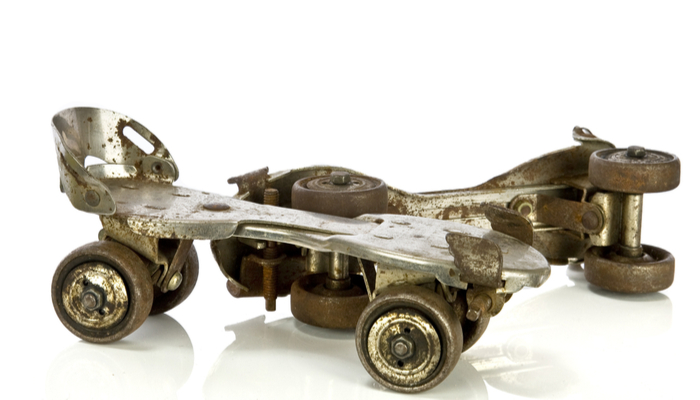Back in the day, there were lots of small, old-fashioned things and tools that today’s kids and even some younger adults might not recognize. These items are from a time long ago, and not many people today know what they were used for. But recently, a picture of a strange coppery metal thing has been going around on the internet, and it’s making people scratch their heads, wondering, “What is this thing?” Well, don’t worry, we’re here to tell you what it is.
An Unexpected Answer
At first glance, this mysterious object may appear to be a specialized wrench or a bottle opener due to its shape and design. However, none of these guesses are correct. In actuality, this object is an old skate tool used for adjusting roller skates. But not just any roller skates – we’re talking about the metal skates that were commonly used prior to the 1970s. These metal skates were essentially pieces of metal with four wheels and straps to attach them to your regular shoes. They were the epitome of old-school roller skating.

Imagine a time when roller rinks were the social hubs of communities, and young folks flocked to them for a night of fun and dancing on wheels. These metal skates, often handed down from one generation to the next, were essential tools for skaters. They allowed skaters to adjust the tightness of the straps, ensuring a snug fit for a secure and comfortable ride. As roller skating has evolved over the years, these old skate tools have become relics of a bygone era, serving as a nostalgic reminder of the simpler, yet incredibly enjoyable, pastime of roller skating.
Adjusting Roller Skates with the Skate Tool
The main purpose of the skate tool was to ensure that the roller skates fit the wearer’s feet properly. It allowed users to adjust both the length and width of the skates for a comfortable skating experience. While skating, many people would wear their skate tool around their neck to prevent it from getting lost. When not in use, the skate tool could be found hanging up in bedrooms, serving as a reminder of the fun times spent on wheels.
Over time, strap-on metal skates gave way to the boot-style skates that we see today. The old metal skates tended to wear out quickly and wreak havoc on shoes. However, there are now companies producing modern versions of these retro skates that can be attached to regular shoes, making them more portable and convenient for skating enthusiasts.
Exploring the Legacy of Roller Skating
Roller skating has left an enduring mark on American culture. It was a beloved pastime that brought joy and laughter to countless people of all ages. The quirky skate tool, now a forgotten relic, played a crucial role in ensuring a comfortable fit for roller skates. But beyond its practical use, roller skating became a cultural phenomenon, with songs like “Brand New Key” immortalizing the exhilarating experience of gliding on wheels.

As time went on, roller skating evolved, and the strap-on metal skates gave way to the more modern boot-style skates. These new designs offered enhanced comfort and stability while reducing the wear and tear on shoes. However, the nostalgia for the simpler times of metal skates still persists.
Today, roller skating is experiencing a resurgence in popularity. People of all ages are embracing this timeless activity for its fun, fitness benefits, and nostalgic appeal. Roller skating rinks are once again bustling with laughter and music, bringing communities together and creating cherished memories.
Revisiting the Joys of Roller Skating
If you’re curious about exploring roller skating, here are a few tips to get started:
- Find a local roller skating rink: Many communities have skating rinks where you can rent skates and enjoy a day on the rink with friends and family.
- Invest in a pair of roller skates: If roller skating becomes a hobby you wish to pursue regularly, consider purchasing your own pair of roller skates for a personalized fit and enhanced performance.
- Join a roller derby team: Roller derby has seen a resurgence in popularity and offers a unique blend of athleticism and camaraderie.
- Take lessons: If you’re new to roller skating or want to brush up on your skills, there are often classes available to help you improve your technique and confidence on wheels.
Roller skating is not only a fun activity but also a great way to stay active and improve your balance and coordination. So lace up your skates, hit the rink, and rediscover the joy of gliding along to the upbeat tunes of the roller disco era.
Tips to Stay Safe While Skating
Skating can be a thrilling and enjoyable activity, but it also comes with its fair share of risks. Whether you’re a seasoned skater or a beginner, prioritizing safety should be your top concern. Here are some essential tips to help you stay safe while skating:
- Wear Protective Gear: Always don protective gear, including a helmet, knee pads, elbow pads, and wrist guards. These items can provide crucial protection in case of a fall or collision.
- Choose the Right Location: Select skating locations carefully. Opt for smooth, well-maintained surfaces like skate parks, designated skate rinks, or paved trails. Avoid skating on uneven or rough terrain to reduce the risk of accidents.
- Check Your Equipment: Regularly inspect your skates and equipment for any signs of wear and tear. Ensure that your wheels, bearings, and brakes are in good condition and functioning properly.
- Learn Proper Technique: Take the time to learn and practice proper skating techniques, including stopping and turning. Knowing how to control your speed and maneuver effectively can prevent accidents.
- Stay Visible: If skating at night or in low-light conditions, wear reflective clothing or accessories to make yourself more visible to others, especially if you’re sharing the road or path with pedestrians or cyclists.
- Follow Traffic Rules: If skating on roads or in areas with traffic, obey traffic rules and signals, and skate in the same direction as vehicles. Use hand signals to indicate turns and stops.
- Stay Aware: Always be aware of your surroundings. Keep an eye out for obstacles, pedestrians, and other skaters. Avoid distractions like headphones or texting while skating.
- Practice Falling Safely: Learning how to fall correctly can minimize the risk of injury. Try to roll with the fall rather than brace yourself with outstretched arms, which can lead to wrist injuries.
- Skate with a Buddy: Skating with a friend can provide added safety. You can look out for each other and provide assistance in case of emergencies.
- Know Your Limits: Don’t attempt tricks or maneuvers that are beyond your skill level. Progress gradually and challenge yourself safely.
By following these safety tips, you can reduce the chances of accidents while enjoying the excitement of skating. Remember, safety should always come first, allowing you to have a fun and injury-free skating experience.
The Enduring Appeal of Roller Skating
Despite the passage of time, roller skating remains a beloved activity that evokes a sense of nostalgia for simpler times. The skate tool, once an essential item for every roller skater, symbolizes the carefree spirit of old-school roller skating and the cherished memories associated with it.
So the next time you stumble upon a forgotten relic from the past, take a moment to embrace the memories it represents. Whether it’s an outdated gadget or an old song, these cultural artifacts connect us to a time when roller skating ruled the streets and rinks, and a simple pair of metal skates could spark joy and adventure.
Sources:
The Not-So-Secret History of Roller Skating
The History of Roller Skates
Do You Remember What This Copper-Colored Object Is?

This Site Was Inspired By An Interest in Protecting the Environment:
We had the privilege and joy of learning from Dr. Charlie Stine who instilled a love for the natural world through incredible field trips with the Johns Hopkins Odyssey Certificate program in Environmental Studies. At the time, the program was endorsed by the Maryland Department of Natural Resources. Sadly, after Dr. Stine retired, the program was phased out. We hope that we honor his legacy by shining a bright light on environmental issues and sharing good news about the success of various conservation programs when possible.

